|
“My authority ends at that door…”
-Pope Benedict XVI-
Mass
Facing the People:
Novelty in the Name of the Pope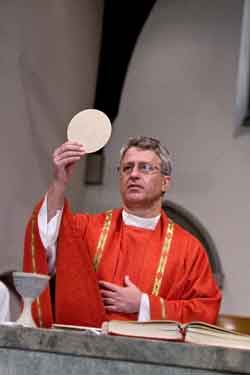
(www.RemnantNewspaper.com)
In his historic Motu Proprio Summorum Pontificum
of July 7, 2007, Pope Benedict declared with the full
authority of his office what traditionalists had always
known: that the typical edition of the Roman Missal
promulgated in 1962, representing the immemorial Roman
liturgy, was “never abrogated” by Paul VI (numquam
abrogatam). In the accompanying letter to the
worldwide episcopate, Pope Benedict was at pains to draw
“attention to the fact that this Missal was never
juridically abrogated and, consequently, in principle,
was always permitted.”
Always permitted. And yet for forty years after the
first public celebration of Pope Paul’s New Mass on
October 24, 1967—a Biblical epoch of suffering—the
Church groaned under the burden of the falsehood that
the traditional Mass had been abrogated, or “obrogated”
(eliminated by substitution) as the neo-Catholic
establishment now contends in a hasty revision of its
discredited propaganda. Concerning that propaganda, we
must never forget that neo-Catholic apologists for the
post-conciliar revolution insisted for decades that
“celebration of the Tridentine Mass is forbidden
except where ecclesiastical law specifically allows it.”
(Likoudis and Whitehead, The Pope, the Council, and the
Mass, 1982, 16, 67-68; 2000, 68) (my emphasis). The
Church’s received and approved rite of Mass, the very
substance of the living Faith of our Fathers,
forbidden. So they told us, until Pope Benedict
exposed the lie.
The Rise of the Legislating Church
Since Paul VI never actually abrogated the traditional
Mass—an act that would have been “quite alien to the
spirit of the Church,” as the former Cardinal Ratzinger
put it—whence did this monstrous fraud originate? The
answer lies in the bureaucratization of the Roman Curia
and the Church at large during the wave of “reforms”
following the Second Vatican Council. As Michael Davies
observed in his landmark study of the liturgical
revolution, “the Conciliar Church could well be termed
the legislating Church… It has become a bureaucracy for
the sake of bureaucracy and has given up any pretense at
evangelizing the de-Christianized masses in Western
countries in favor of producing an endless stream of
legislation to regulate a diminishing number of the
faithful.” (Pope Paul’s New Mass, 21-22).
Communion in the Hand
Novelty in
the Name of the Pope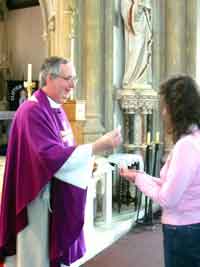
Note well the paradox Davies identified: more and more
legislation for fewer and fewer faithful. Over the past
five decades the Church has suffered the decomposition
of the human element of the ecclesial commonwealth in a
manner paralleling that of the fall of Rome, with its
proliferation of laws accompanied by a loss of societal
integrity. Cardinal Ratzinger called it a “continuing
process of decay.” (L’Osservatore Romano,
November 9, 1984). As Chesterton famously observed of
this sort of process: “When you break the big laws, you
do not get freedom; you do not even get anarchy. You get
the small laws.” The post-conciliar “reformers” broke
some very big laws indeed, first and foremost the law of
the Church’s organic liturgical development, thus
producing what the former Cardinal Ratzinger has called
“a break in the history of the liturgy, whose
consequences could only be tragic.” (Milestones,
p. 148). Thereafter followed the endless stream of
little laws by which the Legislating Church has
systematically ruined the Roman Rite.
The destruction of the Roman Rite was entirely a
bureaucratic operation that Pope Paul VI allowed to run
amuck before he finally sacked the infamous Bugnini on
suspicion of Freemasonic affiliation and packed him off
to Iran in 1976. But the ill-starred Pope acted far too
late to undo the incalculable damage Bugnini had done in
the process of what he himself had called “a major
conquest of the Catholic Church” two years earlier.
(Davies, “How the liturgy fell apart: the enigma of
Archbishop Bugnini,” AD2000 Vol. 2 No 5 (June 1989), p.
17).
As Davies showed, there are only “two papal acts
included among the plethora of over 200 post-conciliar
acts of liturgical legislation.” (Ibid., 23). Those two
papal acts were the Motu Proprio Sacram Liturgiam
(January 25, 1964), which opened the floodgates to
optional vernacular translations of the New Mass that
the bishops soon made de facto mandatory, and
Missale Romanum (April 3, 1969), the Apostolic
Constitution by which Pope Paul promulgated the Latin
typical edition of his new Missal, but without
abrogating the old Missal. In fact, every single
particular of the vernacular Novus Ordo, including the
de facto abolition of the Latin liturgy, is the
work of Bugnini, his bureaucratic collaborators, and
their successors down to the present day, toiling away
in the new congregations, pontifical commissions,
national bishops’ conferences, and local liturgical
commissions created during the post-conciliar “reforms.”
A careful study of the matter reveals that not one
of these liturgical innovations was ever imposed upon
the Church by an affirmative papal act binding the
faithful to embrace it. The entire liturgical
revolution—from vernacular translations to altar
girls—has proceeded by way of optional novelties
approved by hierarchs and bureaucrats at various levels
of the Legislating Church.
Altar
Girls:
Novelty in the Name of the Pope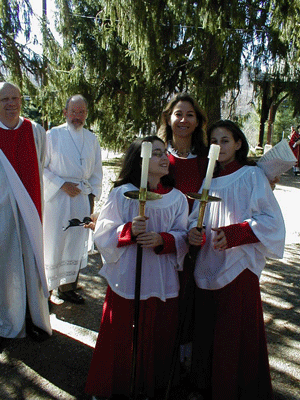
The altar girl debacle is a prime example of the
consequences of the rise of the Legislating Church. The
permission for altar girls came by way of advice from
the newly constituted Congregation for Divine Worship
and the Discipline of the Sacraments (CDW) in 1994. The
CDW resulted from the unification of the Congregation
for Divine Worship, newly created by Paul VI in 1969,
with the previously existing Congregation for the
Discipline of the Sacraments. (It was Pope Paul’s
decision to place Bugnini in charge of the CDW that led
to the liturgical vandalization of the Church.) In
approving altar girls, the CDW passed the buck to the
Pontifical Council for the Interpretation of Legislative
Texts (PCILT), created by John Paul II in 1988 to
replace the Pontifical Council for the Interpretation of
the Decrees of the Second Vatican Council, created by
Paul VI in 1967.
According to the PCILT, the newly adopted Canon 230 of
the 1983 Code of Canon Law permits altar girls pursuant
subsection 2, which provides: “…. All lay persons can
also perform the functions of commentator or cantor,
or other functions, according to the norm of law.”
(Cf. Circular Letter to the Presidents of Episcopal
Conferences from Pontifical Council for Interpretation
of Legislative Texts, Prot. n. 2482/93, March 15, 1994,
Notitiae 30 [1994] 333-335). Notice that the
authorization of altar girls, which overturned 2,000
years of traditional practice, was found to be lurking
in a provision of the Code of Canon Law apparently
construed as if it were a civil statute containing
broadly permissive legal language with no mooring in
ecclesiastical tradition. Here we see the peril
involved in the promulgation of “codes” of Church law as
if they were civil statute books—a peril Brian McCall
has explored on these pages.
Demonstrating precisely the positivistic peril of
canonical codes, which are subject to legislative
modification and repeal, an article in The News York
Times hailing the advent of altar girls quoted a
Manhattan priest and canonist to the effect that “Canon
law changes by some people being out on the cutting edge…
The practice may not be congruent with the regulations,
but regulations catch up with custom.” (NYT,
April 15, 1994). That is, the Legislating Church, like
any civil legislature, will modify or repeal its laws to
keep pace with the times.
According to the CDW’s 1994 advisory, “Pope
John Paul II confirmed the [PCILT] decision and ordered
its promulgation,” but there is no written evidence or
other particulars concerning this “order,” such as the
date it was purportedly given. Further, the papal
“order” approving altar girls contradicted the papal
order reflected in
Inestimabile Donum,
the 1980 instruction by which the CDW advised that “Women
are not, however, permitted to act as altar
servers” and that “[t]his instruction… was approved on
April 17, 1980, by the Holy Father, John Paul II, who
confirmed it with his own authority and ordered it to be
published and to be observed by all concerned.” No
explanation has ever been offered for the Pope’s
purported reversal of his own prior order. Evidently,
it was deemed sufficient merely to report that the
Legislating Church had repealed its prior legislation,
and that the Pope had endorsed the repeal.
The
Luminous Mysteries:
Novelty in the Name of the Pope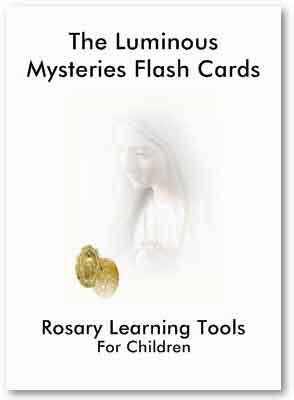
So, it is the Legislating Church, not papal commands as
such, that has produced the “auto-demolition” belatedly
lamented but never undone by Paul VI or John Paul II.
Only Benedict XVI has attempted to overrule something of
what the Legislative Church enacted during the prior two
pontificates. He has liberated the Latin Mass from its
bogus prohibition by the Legislating Church; and, at
long last, he has ordered correction of numerous blatant
errors in the vernacular translations of the Novus Ordo
that the Legislating Church, acting through the Vatican
bureaucracy, the International Commission on English in
the Liturgy, the bishops’ conferences and other organs,
had foisted on the faithful for decades. Those errors
include tampering with the very words of Our Lord
Himself at the first Mass, when He declared that the
fruits of the Holy Sacrifice are offered “for many”—that
is, for the elect unto salvation as the Council of Trent
declared—not “for all,” as the Legislating Church would
have it.
The Pope as Captive of the Legislative Church
But it seems Pope Benedict feels he can do little to
enforce his will against opposition by operatives of the
Legislating Church both within and without the Curia,
including bishops who resent any infringement of their
legislative prerogatives under the “new model” of
collegiality. Hence the traditional Mass continues to be
hermetically sealed off like anthrax in most dioceses,
despite the Pope’s clearly expressed will that every
priest in the Western Church have recourse to the 1962
Missal without need of episcopal permission. And the
national hierarchies of Italy and Germany are openly
defying correction of the defective vernacular
translations of the New Mass.
The Pope’s letter to the head of the German Bishops’
Conference, Archbishop
Robert Zollitsch, regarding the pro multis issue
is a prime example of papal impotence before the
Legislating Church. The Pope advises Zollitsch that “the
Holy See has decided that in the new translation of the
Missal, the words ‘pro multis’ should be
translated as they stand, and not presented in the form
of an interpretation.” That is, the Pope presents as a
mere “decision”—a decision of the Legislative
Church—that there should be a return to the correct
rendering of the words of Our Lord at the first
Mass, thereby rectifying an error not found even in
Protestant versions of the Bible.
The Pope also expresses concern about
“the
danger that… some parts of the German language area will
keep the translation ‘for all,’ even though the German
Bishops’ Conference had agreed to use ‘for many’, as was
desired by the Holy See.” There is not the slightest
suggestion that the Pope has any authority to command
correction of the error as required by fidelity to the
Gospel and his own duty as Vicar of Christ. Rather, this
is all a matter of agreement between organs of the
Legislating Church: the Holy See on the one hand, and
the German Bishops’ Conference on the other. Nowhere in
the letter does the Pope express his own will as Roman
Pontiff, adverting only to what the Legislating Church
has decided and agreed.
The depth of the current ecclesial crisis is reflected
in the Pope’s subsequent comment in defense of the
“decision” to translate Our Lord’s words correctly:
If this decision makes a great deal of sense, as
I hope it does, in terms of the fundamental
relationship between translation and exegesis, I am also
aware that it poses an enormous challenge to those with
the task of explaining the word of God in the Church,
since to the ordinary church-goer it will almost
inevitably seem like a rupture at the heart of the
sacred. They will ask: did Christ not die for all?
Has the Church changed her teaching? Can she do so? May
she do so? Are there reactionary forces at work here
to destroy the heritage of the Council?
Liturgical Dance:
Novelty in the Name of the Pope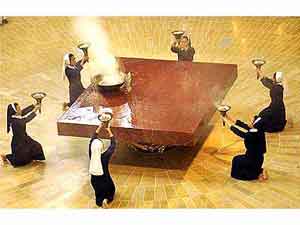
Notice how the Pope, writing in tones almost apologetic,
implicitly accepts the premise that the “heritage” of
the Second Vatican Council is somehow at variance with
the bimillenial “Tridentine” theology of the Mass as a
sacrifice that avails only the elect, not all men, unto
salvation—which is why Our Lord said “for many” and not
“for all.” And it is breathtaking to see the Pope
seriously pose the question whether a return to a
faithful translation of Our Lord’s words reflects the
influence of “reactionary forces” seeking to “destroy
the heritage of the Council”—forces that would repeal
what the Legislating Church has enacted to update her
teaching in keeping with the all-important conciliar
aggiornamento. The Pope appears to cater to the
idea that the Council is exactly what he said it should
not be when speaking as Cardinal Ratzinger: “an
end of Tradition, a new start from zero.” (Address to
Chilean Bishops, 1988).
Even more disturbing is the Pope’s subsequent rhetorical
question: “The question immediately arises: if Jesus
died for all, then why did he say ‘for many’ at the Last
Supper? And why do we retain these words of Jesus for
the institution?”
Why do we retain the words of Jesus? The
Church “retains” them, of course, because they are
His words and she has a divinely imposed duty not to
tamper with them. The Pope does go on to say that the
Church employs the phrase “for many”
out of “deference for Jesus’
own words, in order to remain literally faithful to him.
Respect for the words of Jesus himself is the reason for
the formulation of the Eucharistic Prayer.” But surely
this is not a matter of mere “deference” to or “respect”
for Jesus. The Church has a sacred obligation to obey
the Godhead by conveying His Gospel without alteration.
“Deference” and “respect” connote discretion not
to defer or respect. It is precisely this discretion
that the Legislative Church has claimed for itself and
to which—irony of ironies—Benedict now defers by
pleading for acceptance of the Holy See’s “decision” to
return to what Our Lord actually said versus what
opposing elements of the Legislative Church would prefer
Him to have said.
The Pope continues with an observation whose irony could
not be more exquisite; and one wonders how the irony
could have been lost on the Pope:
We all know from experience of the last fifty years how
deeply the alteration of liturgical forms and texts
touches people’s souls. How greatly perturbed people
will be, then, by a change in the text at such a key
moment. This being so, when the decision was made to
opt for the translation “many”, in view of the
difference between translation and explanation, it was
established at the same time that a thorough
catechesis would be needed to prepare the way for this
translation in the various language regions: the
bishops would have to help the priests, and through them
the lay faithful, to understand exactly what this is
about. Prior catechesis is the essential condition for
adoption of the new translation.
But where was this concern for the effect of liturgical
changes upon the souls of the faithful during the
pontificates of Paul VI and John Paul II, when the
entire Roman Rite was dramatically altered with patently
disastrous results and without the least attempt at “a
thorough catechesis… to prepare the way”? And notice
that here again the Pope reduces the duty to convey
faithfully the words of God Himself at the first Mass to
a mere “decision… to opt for the translation
‘many’”—another nod to the prerogatives of the
Legislating Church versus the Church of Sacred
Tradition.
Yes, Prime Minister!
Cardinal Bertone
Master of
Novelty in
the Name of the Pope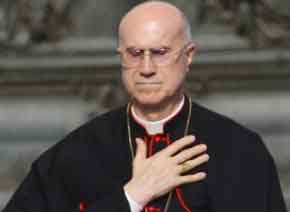
I will conclude by noting another layer of the problem
of the Legislating Church. A key element
in the bureaucratization of the Roman Curia during the
pontificate of Paul VI was the elevation of the Vatican
Secretary of State to the status of virtual prime
minister of the Church—that is, prime minister of the
Legislating Church, for the Secretary of State is no
part of the divine constitution of the Church founded by
Our Lord on the Rock of Peter.
In 1967-68, under the authority of Pope Paul’s apostolic
constitution Regimini Ecclesiae Universae, the
Curia underwent a dramatic restructuring designed and
implemented by then Vatican Secretary of State, Cardinal
Jean-Marie Villot, another suspected Mason. The aim was
to eliminate, as much possible, what we are now told is
the old “monarchical model” of the Church in favor of
the new “model” of collegiality. Before the Council,
the Curia was indeed structured along monarchical lines.
The Pope was Prefect of the Holy Office, to which all
other Vatican dicasteries were subordinated, while the
Cardinal in charge of the day-to-day business of the
Holy Office was the Pro-Prefect, reporting directly and
only to the Pope. The Pope, as Vicar Christ on earth,
was thus at the head of a chain of command over which he
wielded his authority directly or through the Holy
Office.
Under the “reform” engineered and carried out by Villot,
however, the Holy Office was renamed, becoming the
Congregation for the Doctrine of the Faith (CDF)—the
name “Holy Office” being far too old-fashioned for the
Church’s “new orientation” after the Council. The
Cardinal Secretary of State was placed above all the
Vatican dicasteries, including the CDF. Worse, the Pope
was no longer Prefect of the former Holy Office, which
(as the CDF) would now be under a Cardinal Prefect
organizationally subordinated to the Secretary of State.
In short, Paul VI “enhanced the powers of the Secretary
[of State], placing him over all the other departments
of the Roman Curia.” (Cf. “Cardinal Secretary of State,”
http://en.wikipedia.org /wiki/Cardinal_Secretary_of_State).
Since the Council the Vatican Secretary of State has
been constituted a kind of Vicar of the Vicar of Christ,
with a resulting functional detachment of the new
Legislating Church from direct papal control. This
decidedly unfavorable development was only exacerbated
by John Paul II’s apostolic constitution Pastor Bonus,
which declares broadly: “The
Secretariat of State provides close assistance to the
Supreme Pontiff in the exercise of his supreme office.”
The First Section of the Secretariat of State is
accorded sweeping authority, including the authority
·
to draw up and dispatch apostolic constitutions,
decretal letters, apostolic letters, epistles, and other
documents entrusted to it by the Supreme Pontiff;
·
to prepare the appropriate documents concerning
appointments to be made or approved by the Supreme
Pontiff in the Roman Curia and in the other institutes
depending on the Holy See…
·
to prepare for publication the acts and public documents
of the Holy See in the periodical entitled Acta
Apostolicæ Sedis;
·
through its special office commonly known as the Press
Office… to publish official announcements of acts of
the Supreme Pontiff or of the activities of the Holy
See;
·
to oversee the newspaper called L’Osservatore Romano,
the Vatican Radio Station, and the Vatican Television
Centre.
·
to collect, organize[], and publis[] all data, set down
according to statistical standards, concerning the life
of the whole Church throughout the world.
Thus the Secretary of State, as Prime Minister of the
Legislating Church, has been vested with all but total
control over the flow of legislation and other
information emanating from the Vatican, including the
very acts of the Pope himself. “Yes, Prime Minister!”
is the new order of things in the post-conciliar Church.
Indeed, as John Vennari has noted, the episodes of that
hilarious British comedy series furnish a remarkable
allegory of the state of the Church today, in which
politics takes precedence over reality. We have even
seen the Secretary of State asserting control over
publication of the Third Secret of Fatima, arrogating to
himself—in an utterly surreal development—authority to
“interpret” the vision of the “bishop dressed in white”
as a mere depiction of events in the 20th
century, culminating in the failed attempt on the life
of John Paul II in 1981. In the Vatican’s official
booklet accompanying publication of the vision on June
26, 2000, the former Cardinal Ratzinger defers
repeatedly to the “interpretation” of the vision by
former Secretary of State Cardinal Angelo Sodano:
·
“an interpretation, the main lines of which can be found
in the statement read by Cardinal Sodano”
·
“In this regard, Cardinal Sodano stated: “[the vision]
do[es] not describe photographically the details of
future events, but synthesize[s] and compress[es]
against a single background facts which extend through
time in an unspecified succession and duration.”
·
“the interpretation offered by Cardinal Sodano in his
statement of 13 May was first put personally to Sister
Lucia….”
·
“First of all we must affirm with Cardinal Sodano:
‘... the events to which the third part of the ‘secret'
of Fatima refers now seem part of the past.’”
We must affirm with Cardinal Sodano? What authority
does Cardinal Sodano have over the Message of Fatima?
None but what the Legislating Church purports to give
him, which in reality is no authority at all, as the
Legislating Church is not the Church that Our Lord
founded, but rather a collection of bureaucratic
fiefdoms which in no way participate in the Church’s
charisms of indefectibility and infallibility in matters
of faith and morals.
Yet Sodano was absurdly vested with the status of the
oracle of Fatima—and this at the very moment he was
facilitating the cover-up of the Father Maciel scandal,
as he had been throughout the 1990s. (See the damning
report “The Allegations Against Cardinal Sodano” in
Catholic World Report, May 4, 2001). For the
Legislating Church and its Prime Minister, the Fatima
event is a public relations problem to be managed, not a
heaven-sent prophesy and warning for the Church and
mankind. And Sodano’s successor, Cardinal Bertone,
continues unswervingly in the Secretary of State’s party
line on Fatima: that the Message of Fatima in general
and the Third Secret in particular “belong to the past.”
Our Lady of Fatima, the Secretary of State assures us,
had nothing to say about the ecclesial disaster of the
past half-century.
The “Vatileaks” Scandal
The 'Spirit of Vatican II' Set UP
a Regime of Novelty in
Peter's Name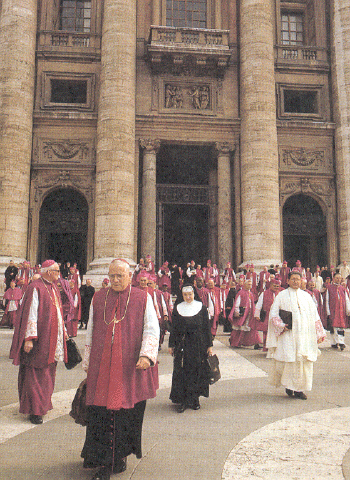
The dominance of the Secretary of State over the affairs
of the Legislating Church has been revealed to the whole
world in the scandal now raging over the contents of
private correspondence to the Pope leaked from the papal
apartment by the Pope’s majordomo (head of
household), Paolo Gabriele. Among the leaked items is a
most revealing letter to Cardinal Bertone from Cardinal
Leo Raymond Burke, who is head of the Apostolic
Signatura (the Catholic Church’s highest tribunal) and
is also a member of the CDW.
In an article dated June 3, 2012, the Italian daily
La Repubblica quoted excerpts from Burke’s letter,
which protests the recent (January 2012) approval by the
Pontifical Council for the Laity—yet another of the
proliferating organs of the Legislative Church—of “those
celebrations contained in the Catechetical Directory of
the Neocatechumenal Way which do not appear by their
nature to be regulated already by the liturgical books
of the Church.” What precisely this ambiguous approval
covers has been the subject of controversy ever since—a
result all too typical of post-Vatican II pronouncements
by Vatican departments. Seizing on the ambiguity, the
two founders of “the Way”—that famous pair of
neo-Catholic kooks, “Kiko” Arguello and Carmen
Hernandez—are claiming approval of the neo-Catechumenal
liturgy as such.
But, quite tellingly, the CDW, which has jurisdiction
over the liturgy, was not involved in this “approval.”
Hence Cardinal Burke’s letter to Secretary of State
Bertone objects to an invitation Burke had found on his
writing desk, announcing a ceremony marking the
“occasion of the approval of the liturgy of the
Neocatechumenal Way.” Wrote Burke: “I cannot, as
Cardinal and member of the Congregation for Divine
Worship, fail to express to Your Eminence the
astonishment the invitation has caused me. I do not
recall ever having heard of a consultation [with the CDW]
regarding the approval of the liturgy as such of this
ecclesial movement. I have received in recent days from
various persons, including a respected bishop in the
United States, expressions of concern regarding such a
papal approval. This news had been for me pure rumors
and speculations. Now I have discovered that they were
correct.” As reported by La Repubblica, the
letter ends with Cardinal Burke’s declaration that “As a
faithful student of the teaching of the Holy Father on
the liturgical reform that is fundamental to the new
evangelization, I believe that such liturgical
innovations, even after the correction by the Prefect of
the [CDW], do not seem consistent with the liturgical
magisterium of the Pope.”
In a further revelation, John Allen of National
Catholic Reporter reports that the Pope read and
then attached a handwritten note to Burke’s letter,
stating: “Return to Card. Bertone, inviting Card. Burke
to perhaps translate these very correct observations in
the Congregation for Divine Worship.” Yet these “very
correct” observations by Cardinal Burke concerning the
Pope’s teaching on the liturgy have not impeded what is
now being trumpeted as “Vatican approval” of the bizarre
liturgy of the Neocatechumenal Way, which includes
dancing around an altar table, consecrated Hosts the
size and consistency of personal pan pizzas which
crumble and leave numerous particles on the floor, lay
preaching in the form of “resonances,” standing
throughout a “Eucharistic Prayer” accompanied by guitar
music, and the reception of Holy Communion while
standing in the pews.
A Revealing Incident
How is it that the Vicar of Christ is reduced to the
suggestion that Cardinal Burke’s “very correct
observations” concerning the abuses of the
Neocatechumenal “liturgy” be translated for the benefit
of the CDW? Why does the Pope himself not intervene
directly to put a stop to the liturgical atrocities of
“the Way” of Kiko and Carmen? Indeed, why does the Pope
not simply govern the Church directly, restoring good
order in keeping with the Power of the Keys that is his,
and his alone?
The answer is revealed by an incident of which I was
reliably informed during a recent Ignatian retreat at
the Retreat House of the Society of Saint Pius X in
Ridgefield, Connecticut. During an audience with the
Pope, Bishop Fellay found
himself alone with the Pope for a moment. His
Excellency seized the opportunity to remind the Pope
that he is the Vicar of Christ, possessed of the
authority to take immediate measures to end the crisis
in the Church on all fronts. The Pope replied thus: “My
authority ends at that door.” (Castel Gondolfo August,
2005)
Today it appears that the Vicar of Christ has become a
captive of the democratization of the Church according
to a model of “collegiality” that purports to replace
the monarchy which the papacy established by Christ the
King really is. It seems that the Pope views himself as
but a cog, albeit the biggest and most important cog, in
the vast clockwork of a Legislating Church whose
“decisions” must be allowed to operate autonomously and
by consent of the governed in keeping with the collegial
and democratic mechanisms of the new model. No longer
seeing himself as a monarch with the prerogatives and
peremptory authority of a monarch, the Pope of the
Legislating Church feels constrained to rely on mere
suasion and appeals to procedural due process in the
hope of effectuating what he wishes to see done.
“They have uncrowned Him,” as Archbishop Lefebvre so
famously observed of Christ the King. And thus have they
uncrowned His Vicar as well. A crownless Vicar of Christ
stands at the turbulent center of the still-reigning
chaos in the Church. Only when the papal crown is
restored will the good order of the Church be restored
with it. Pray, then, that the Pope will have the
courage to replace the crown that Christ has given him
to wear. |
